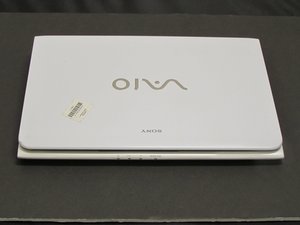crwdns2862678:0crwdne2862678:0
crwdns2895503:0crwdne2895503:0
Sony Vaio SVE111B11L Personal Laptop
NOTE: With all Sony Vaio SVE111B11L parts, software or device drivers can be found through Sony's customer service. These can be found by part number, device requirements or by desired upgrade. All parts or drivers can be bought from Sony, or by the numbers provided by Sony's customer service, the part or parts can be ordered from a third party such as Amazon.
Computer Will Not Power On
The laptop will not respond or show any sign of powering up.
Battery Melting
Check to make sure the battery is in the battery port. If it is, make sure the charging adapter is working by removing the battery. Then, with the charging adapter plugged in the laptop should power on normally. If this overheating continues. Contact the customer support, or purchase a replacement battery. After receiving the new battery place it into the battery port making sure it is in place.
Faulty Battery
If the charging adapter is plugged in, and the charge light is on. Make sure the charging adapter is connected to the laptop. If the laptop only powers up when the adapter is plugged in, regardless of charging time, then the battery is faulty. Replace the battery.
Keyboard/Keys Not Responding
The keys on the keyboard won't respond or appear to be broken or missing.
Faulty Keyboard
If the keys fail to register in the laptop, it may be due to software error. If this is the case, get the drivers from the Sony customer support and install them. If this does not fix the problem the entire keyboard may be faulty. Contact Sony customer support for the part or part number then replace the keyboard assembly.
Keys Are Not Responsive
When keys can't be pressed, there may be something below the physical key holding it up. To fix this, make sure nothing is stuck below it. You may need to wipe off the area underneath. Once it is sufficiently clean, snap the key back into position. If still unresponsive, replace keyboard assembly.
Keys Are Missing
The keys on the keyboard are missing. Replace keys or entire keyboard assembly.
Melted Keyboard
If keyboard is melted, check battery and fan. Make sure they are in working order. If not, replace battery or fan. After you verify they are working, order a new keyboard assembly.
Computer Screen Will Not Power On, No Display
Computer screen will not power on, has no image on screen.
Blue Screen
If your computer displays a blue screen, check battery and charging adapter. If further problems persist,replace screen.
Power Intermittent
If screen powers on and off while physically moving the display. check for debris between the computer and the screen. If problem persists check connectors. If further problems occur, replace the screen.
Screen Melting
If screen is distorted or appears to be melted. Check battery and cooling fan, correct problem. If problem continues replace the screen.
Disabled Display
If screen is disabled, visibly broken, or unhinged. Replace screen or hinge.
HDMI/VGA Ports Not Detected
Video output port is not recognized or detected by computer.
Loose Port Connections
Check the connection to the motherboard. If the connections are OK, consider replacing the ports or motherboard. If port is loose on device, or connector is visibly broken. Replace HDMI/VGA port.
Faulty Driver
If driver is not installed, go to product or customer service site to obtain the driver.
Screen Image is Distorted
Screen image is distorted, blurry, or discolored.
Incorrect Resolution
The computer may be operating in an incorrect resolution. To fix this, double check the resolution settings by right-clicking the desktop, and selecting “Screen Resolution.” Alternatively, it is possible to change the resolution by pushing the “Fn” button and then hitting “F4.” This should bring up a small menu where you can select the correct resolution.
Outdated Video Driver
If certain videos flicker, appear blurry, or changes to incorrect colors, the most probable cause for this issue is an outdated video driver. To update the video driver, go to and download the appropriate video driver by checking for the correct version of operating system.
Device is Overheating
While you are working, your computer randomly shuts off without notification.
Dust in Vents or Fans
Computers can overheat due to excessive dust and other materials stuck in the vents or fan. To fix this, use a compressed air to carefully blow the dust off the vents and fan.
Inadequate Amount of Thermal Paste on Connections
Your computer may not have adequate contact between the heat sink and processor. See our fan replacement guide to help you replace the fan. This is usually caused by a lack of thermal paste or by air in between the two components. To fix this, completely clean off any old thermal paste, then apply a bead of new thermal paste directly in the center of the processor. Gently push the heat sink back in place and tighten screws to lock down the heat sink.
Computer will Not Boot
The computer does not turn on, no sounds are heard.
Motherboard Melted Due to Battery Overheating
Computer will not power on when power adapter and battery are properly connected. Visually check the motherboard. If the motherboard is cracked, discolored, has black streaks, or smells burnt. This may indicate that the motherboard is bad. Find the proper replacement motherboard (considering upgrading). Replace motherboard accordingly.
Connectors Broken Due to Excessive Heat (Motherboard OK)
If the motherboard seems to be OK. Check the connections from the power sources. if the solder connections or the connectors are broken. Re-solder connections or replace connectors.


crwdns2944067:00crwdne2944067:0